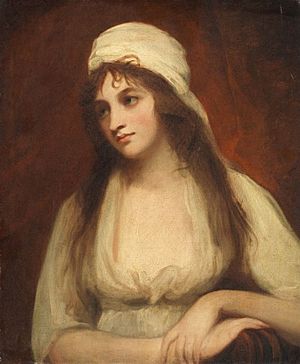Mary Tighe facts for kids
Quick facts for kids
Mary Tighe
|
|
|---|---|

Portrait by George Romney
|
|
| Born | 9 October 1772 Dublin, Ireland |
| Died | 24 March 1810 (aged 37) County Wicklow, Ireland |
| Occupation | Poet |
| Nationality | Irish |
| Period | 1805–1810 |
Mary Tighe (born October 9, 1772 – died March 24, 1810) was an Irish poet. She wrote many poems, and her most famous work is called Psyche.
Contents
Mary Tighe's Life
Mary Blackford was born in Dublin, Ireland, on October 9, 1772. Her mother, Theodosia Tighe, was a religious leader. Her father, William Blachford, was a clergyman. Mary grew up with a very strict religious education.
When she was 21, Mary married her cousin, Henry Tighe. He was a member of the Irish Parliament. People say their marriage was not very happy.
Moving to London
In the early 1800s, Mary and Henry moved to London. There, Mary met other writers and people who loved literature. One of them was Thomas Moore, a famous poet who admired her writing.
Mary had been writing poems since she was a young girl. But she did not publish anything until 1805. That year, she released Psyche, a long poem with six parts. Many people liked Psyche, and Thomas Moore even wrote a poem praising it.
Later Years and Legacy
Mary Tighe became very sick in 1805 with tuberculosis. This was a serious lung disease. She lived for five more years, but her health was very poor. She spent her last months at her brother-in-law's estate in Woodstock, County Kilkenny, Ireland. She was buried in a church nearby.
After she died, a new version of Psyche was published in 1811. This edition also included some of her other poems that had not been published before. This helped her become well-known as a writer. The famous poet John Keats was one of her fans. He wrote a poem called "To Some Ladies" as a tribute to her.
A statue of Mary Tighe was made by the artist Lorenzo Bartolini. It was kept at Woodstock House until the house was burned down in 1922. Her son asked for the statue to be made after she died.
About Psyche
Psyche, or the Legend of Love is Mary Tighe's version of an old Greek and Roman story. This story is about Cupid and Psyche. The original tale was written by a Roman author named Lucius Apuleius.
Mary Tighe first printed only 50 copies of Psyche in 1805 for private use. After she passed away, the poem was released to the public in 1811. This edition included other poems she had written.
The Story of Psyche
The poem tells the story of a princess named Psyche. She was so beautiful that people started to worship her like the goddess Venus. Venus became jealous of Psyche. So, she sent her son, Cupid, to make Psyche fall in love with a monster.
But Cupid accidentally fell in love with Psyche himself! He married her without his mother knowing. He took her to a secret palace. Invisible servants helped her there, and Cupid only visited her at night. This way, she could not see who he really was.
One night, Psyche became very curious. After Cupid fell asleep, she lit a lamp to see his face. She was surprised to see he was a god, not a monster. A drop of oil from her lamp fell and burned Cupid, waking him up. He flew away.
To get her husband back, Psyche asked Venus for help. Venus was still angry and gave Psyche many difficult tasks to complete. In her last task, Psyche had to get a box from the underworld. The box held some of the beauty of the goddess Proserpina. Psyche was told not to open the box. But she did, and she fell into a deep sleep. Cupid saved her, and in the end, Jupiter turned Psyche into a goddess.
Tighe's Unique Version
Mary Tighe's poem mostly follows the original story by Apuleius. But she added small details that show Cupid and Psyche are equal. She also showed that their love was mutual. In the second half of her poem, Cupid even joins Psyche on her difficult journey. This is a big change from the original story.
For example, when Cupid first sees Psyche, he is supposed to make her fall in love. But in Tighe's poem, he accidentally pricks himself with his own arrow. This makes him fall in love with her.
- The dart which in his hand now trembling stood,
- As o'er the couch he bent with ravished eye,
- Drew with its daring point celestial blood
- From his smooth neck's unblemished ivory: (canto 1, 244–247).
This shows that Cupid is also a "victim" of love, just like Psyche.
Later in the poem, Cupid pretends to be a "white knight." He joins Psyche on her tasks. He tells her he is also looking for his lost love.
- “I too (he said) divided from my love,
- “The offended power of Venus deprecate,
- “Like thee, through paths untrodden, sadly rove
- “In search of that fair spot prescribed by fate,
- “The blessed term of my afflicted state,” (canto 3, 127–131).
By doing this, Tighe makes Cupid and Psyche's journey a shared one. They help each other grow and overcome challenges. This makes her version of the story more about mutual love and growth.
Other Works
- Selena (an unpublished novel). You can find the original handwritten copy at the National Library of Ireland.
- Mary: a Series of Reflections during 20 Years (published after her death in 1811).
Images for kids




